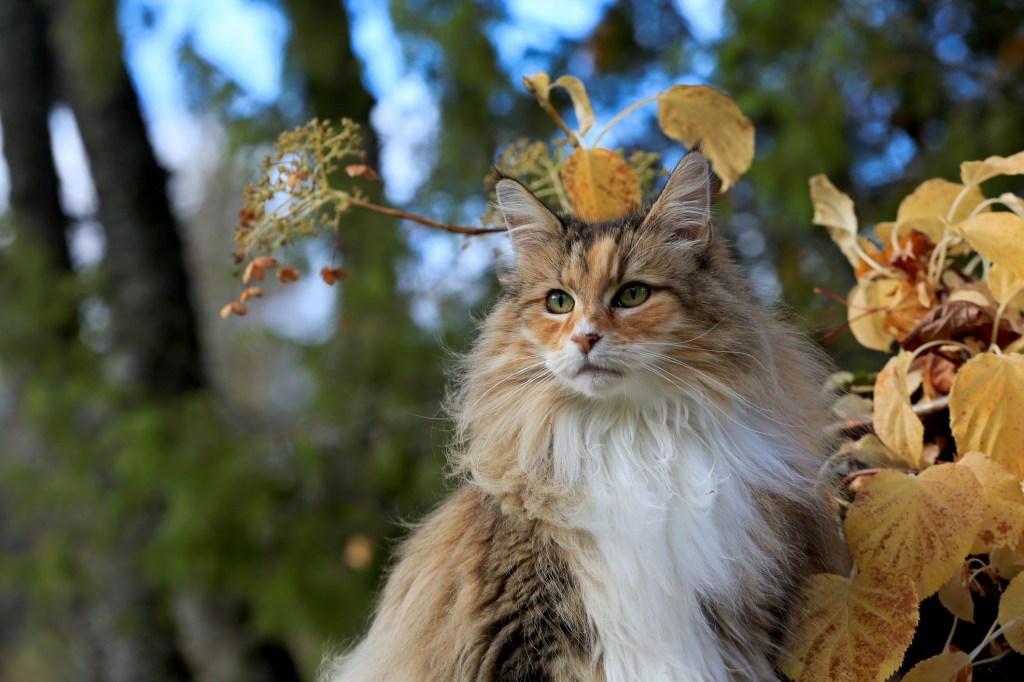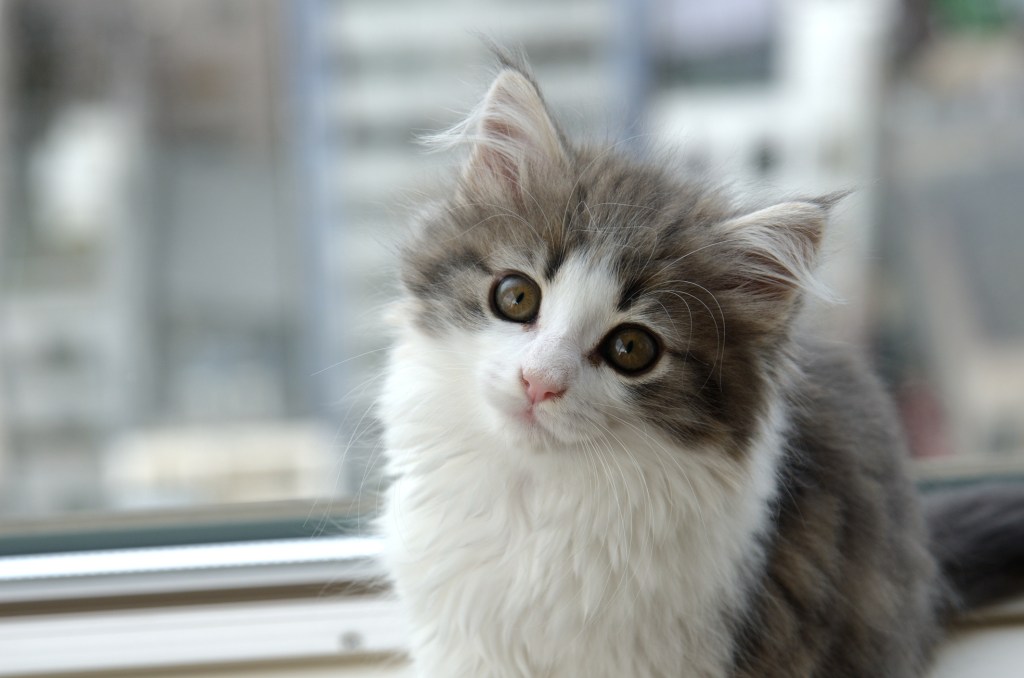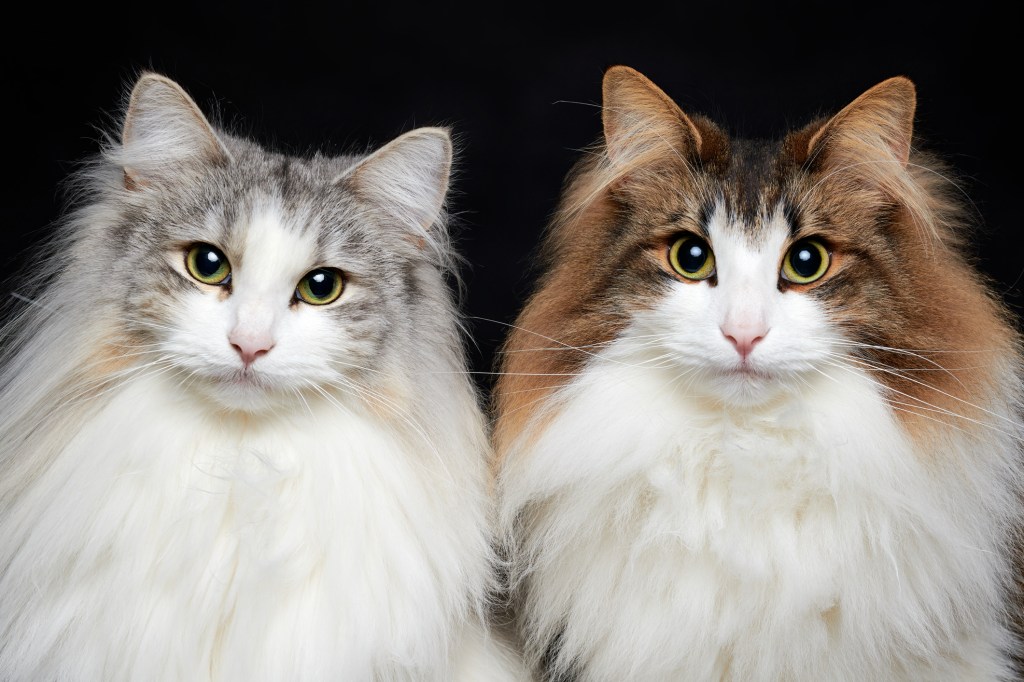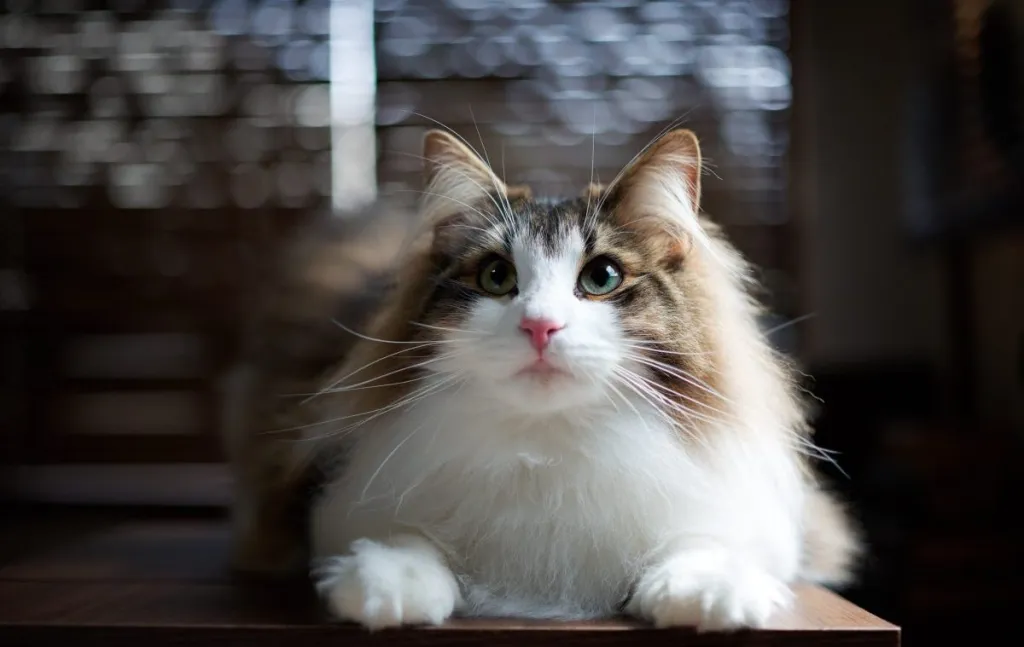The Norwegian Forest cat (also known as the Skogkatt or Wegie) is a large, long-haired cat breed that is native to Norway. They are known for their thick, double coat that helps them to withstand the cold winters in Norway. Norwegian Forest cats are also known for their gentle and affectionate nature, and they make great family pets.
Norwegian Forest cats come in a variety of coat colors, including white, black, blue, red, cream, silver, and golden. They can also have solid, bicolor, tortoiseshell, calico, and tabby fur patterns. The most common coat color is brown tabby. Norwegian Forest cats are relatively rare in the United States, but they are becoming more popular.
When considering a Norwegian Forest, it’s advisable to prioritize adopting from rescue organizations or shelters to provide a loving home to a cat in need. However, if you decide to purchase, it’s crucial to choose a reputable breeder. Conduct thorough research to ensure that the breeder follows ethical practices and prioritizes the well-being of their cats. Reputable Norwegian Forest breeders prioritize the health and temperament of their cats, conduct necessary health screenings, and provide a nurturing environment for the kitties. This active approach ensures that you bring home a healthy and happy kitty while discouraging unethical breeding practices.
Quick Facts
- Origin: Norway
- Size: Medium to large
- Breed Group: Natural
- Lifespan: 12 to 16 years
- Coat: Semi-long, thick, and water-resistant; features a dense undercoat and a bushy tail; comes in various colors and patterns
- Temperament: Friendly, intelligent, and independent; they are known for their strong hunting instincts
- Exercise Needs: Moderate; they enjoy climbing and playing, making cat trees and interactive toys a good choice
- Training: Intelligent and can be trained, but they also have an independent streak
- Grooming: Regular grooming is essential due to their dense fur; brushing helps prevent matting, especially during shedding seasons
- Health: Generally healthy breed, but they can be prone to certain genetic conditions like hip dysplasia and heart disease; regular vet check-ups are important.
- They are the national cat of Norway
- The Norwegian Forest Cat Club of America (NFCA) was founded in 1979
- Norwegian Forest cats were thought to be magical in Norse mythology, and favored by the goddess Freya.
- Freya was the goddess of domesticity, and consequently there are many superstitions linking cats and marriage.
Norwegian Forest Cat Pictures






-
Affectionate with Family
Some cat breeds are typically independent and aloof, even if they’ve been raised by the same person since kittenhood; others bond closely to one person and are indifferent to everyone else; and some shower the whole family with affection. Breed isn’t the only factor that goes into affection levels; cats who were raised inside a home with people around feel more comfortable with humans and bond more easily.

See Cats Less Affectionate with Family -
Amount of Shedding
If you’re going to share your home with a cat, you’ll need to deal with some level of cat hair on your clothes and in your house. However, shedding does vary among the breeds. If you’re a neatnik, you’ll need to either pick a low-shedding breed or relax your standards. This furniture cover can make it easier to clean up cat hair and keep it off your sofa!
-
General Health
Due to poor breeding practices, some breeds are prone to certain genetic health problems. This doesn’t mean that every cat of that breed will develop those diseases; it just means that they’re at an increased risk. If you’re looking only for purebred cats or kittens, it’s a good idea to find out which genetic illnesses are common to the breed you’re interested in.
-
Potential for Playfulness
Some cats are perpetual kittens—full of energy and mischief—while others are more serious and sedate. Although a playful kitten sounds endearing, consider how many games of chase the mouse-toy you want to play each day, and whether you have kids or other animals who can stand in as playmates. A classic wand cat toy like this one is perfect for playful felines!
-
Tendency to Vocalize
Some breeds sound off more often than others with meows, yowls, and chattering. When choosing a breed, think about how the cat vocalizes and how often. If constant “conversation” drives you crazy, consider a kitty less likely to chat.
-
Kid-Friendly
Being tolerant of children, sturdy enough to handle the heavy-handed pets and hugs they can dish out, and having a nonchalant attitude toward running, screaming youngsters are all traits that make a kid-friendly cat. Our ratings are generalizations, and they’re not a guarantee of how any breed or individual cat will behave; cats from any breed can be good with children based on their past experiences and personality.
-
Friendly Toward Strangers
Stranger-friendly cats will greet guests with a curious glance or a playful approach; others are shy or indifferent, perhaps even hiding under furniture or skedaddling to another room. However, no matter what the breed, a cat who was exposed to lots of different types, ages, sizes, and shapes of people as a kitten will respond better to strangers as an adult.
-
Easy to Groom
Some breeds require very little in the way of grooming; others require regular brushing to stay clean and healthy. Consider whether you have the time and patience for a cat who needs daily brushing. You should definitely pick up this awesome de-shedding tool for cats of any hair length!
-
Intelligence
Some cat breeds are reputed to be smarter than others. But all cats, if deprived the mental stimulation they need, will make their own busy work. Interactive cat toys are a good way to give a cat a brain workout and keep them out of mischief. This scratcher cat toy can keep your smart kitty busy even when you’re not home!
-
Pet Friendly
Friendliness toward other household animals and friendliness toward humans are two completely different things. Some cats are more likely than others to be accepting of other pets in the home.
Norwegian Forest History
The Norwegian Forest Cat is native to Norway, with a history going back hundreds and maybe thousands of years. He figures in fairy tales and legends, one being that the Norse goddess Freya’s chariot is pulled by six giant cats. Where or how the cats originated remains a mystery. They may be the descendants of longhaired cats from Turkey, brought back from Byzantium by Scandinavian warriors who served the Byzantine Empire, or they may be related to the Siberian cat from Russia.
They could have been Viking booty, or they could simply have been the result of natural selection: shorthaired cats whose adaptations to the harsh, near-Arctic climate produced descendants with woolly undercoats and long topcoats that shed water with ease.
For centuries, the skogkatt—a Norwegian word that translates as “forest cat”—survived by his wits or offered his services as a mouser to farmers and housewives in exchange for shelter in barns, stables, or homes. In 1938, the cats were exhibited at a show in Oslo, but World War II interrupted any plans for developing them as a breed.
Fortunately, they survived the war, just barely, but there were still some hard decades ahead and little was done with them until the 1970s. In 1977, they were finally registered as a breed with Europe’s Federation Internationale Feline. Two years later, a pair of NFCs was exported to the United States for the first time. The breed has since become popular in Europe and the U.S.
Norwegian Forest Size
These are big cats. Males can weigh 13 to 22 pounds or more, with females somewhat smaller. The Wegie matures slowly and isn’t full grown until 5 years of age.
Norwegian Forest Personality
The Norwegian Forest Cat is satisfied to be in the same room with people and will entertain himself if no one is home. Although he appreciates human company, he can be a bit reserved with visitors. Even with family, he’s not much of a lap cat, but a nice scritch between the ears or beneath the chin is always welcome, and he’ll usually reciprocate with a nice head butt or cheek rub. He communicates with classic Scandinavian restraint.
His quiet voice is employed only when he needs something—dinner on time, perhaps—and rises only if he is ignored. Not surprisingly, this large and athletic cat is a climber. You will often find him at the highest point he can reach in the home, and unlike some cats, he doesn’t have any qualms about descending trees or other heights headfirst.
Thanks to his heritage as a wilderness and farm cat, not to mention his waterproof coat, the Wegie thinks nothing of fishing in a body of water for a nice meal. Aquarium and koi pond denizens, beware! While he loves the outdoors, he is content to live quietly in a home. This is a smart, independent cat who learns quickly and has an alert nature. He likes to play and thrives with a busy family that loves him.
Norwegian Forest Health
Both pedigreed cats and mixed-breed cats have varying incidences of health problems that may be genetic in nature. Norwegian Forest Cats are generally healthy, with a long life span of 14 to 16 years. The following diseases have been seen in the breed:
- Glycogen Storage Disease IV: This is a rare heritable condition that affects the metabolism of glucose. Most kittens with the disease are stillborn or die within a few hours of birth, but occasionally a kitten will not show signs until about 5 months of age and usually die within a few months. A DNA test is available that can identify affected and carrier cats.
- Hypertrophic Cardiomyopathy: This is a form of heart disease that is inherited in some cat breeds such as the Maine Coon. Heritability has not been proven in the Norwegian Forest Cat.
- Polycystic Kidney Disease: This is a genetic condition that progressively destroys the kidneys. No DNA test for the disease is available for Norwegian Forest Cats, but the disease can be detected through ultrasound as early as 10 months of age.
- Retinal Dysplasia: This is an eye defect that causes spots on the retina but does not worsen the cat’s vision.
Norwegian Forest Care
Brush or comb the Norwegian Forest Cat’s long coat once or twice a week, using a bristle brush, wire slicker brush or stainless steel comb. If you run across tangles, work them out gently so you don’t hurt the cat. A bath is rarely necessary, which is a good thing. With the Wegie’s practically waterproof coat, it can be very difficult to get him wet enough for a bath.
Brush the teeth to prevent periodontal disease. Daily dental hygiene is best, but weekly brushing is better than nothing. Wipe the corners of the eyes daily with a soft, damp cloth to remove any discharge. Use a separate area of the cloth for each eye so you don’t run the risk of spreading any infection. Check the ears weekly.
If they look dirty, wipe them out with a cotton ball or soft damp cloth moistened with a 50-50 mixture of cider vinegar and warm water. Avoid using cotton swabs, which can damage the interior of the ear. Keep the litter box spotlessly clean. Like all cats, Wegies are very particular about bathroom hygiene.
A clean litter box will also help to keep their fur clean. He is certainly built to survive a cold climate, but it’s a good idea to keep a Norwegian Forest Cat as an indoor-only cat to protect him from diseases spread by other cats, attacks by dogs or coyotes, and the other dangers that face cats who go outdoors, such as being hit by a car.
Wegies who go outdoors also run the risk of being stolen by someone who would like to have such an unusual cat without paying for it. If possible, build your Wegie a large outdoor enclosure where he can enjoy the elements safely.
Norwegian Forest Coat Color And Grooming
The Norwegian Forest Cat is notable for his long, thick, beautiful coat and large size. The head has an inverted triangle shape, pointed at the chin and then widening on each side up toward the medium to large ears, which are heavily tufted.
Large, almond-shaped eyes are green, gold, or copper, although white cats may have blue eyes or odd eyes (one blue eye and one eye of another color). The moderately long body looks powerful, with its broad chest and heavily muscled thighs. Large round paws have tufts of fur between the toes. The bushy tail is as long as the body.
The weatherproof double coat varies in length. The “bib” begins with a short collar at the neck, “mutton chops” on the side, and a full frontal ruff. Full britches—long hair on the thighs—cover the hind legs. On the body, the coat is long and flowing, but it changes with the seasons. A Wegie in summer looks relatively naked compared to his full winter glory. The coat comes in almost every color and pattern, with or without white, with the exceptions of chocolate, lavender lilac, or a pointed pattern like that of the Siamese.
Children And Other Pets
The friendly, laidback Norwegian Forest Cat is a perfect choice for families with children and cat-friendly dogs. He loves the attention he receives from children who treat him politely and with respect, and he doesn’t mind playing dress-up or going for a ride in a baby buggy.
He is happy to live with other cats and cat-friendly dogs, too, thanks to his amiable disposition. Introduce pets slowly and in controlled circumstances to ensure that they learn to get along together.
Norwegian Forest Rescue Groups
More Info For You
If you’re also looking for a dog, check out DogTime’s dog breed page!





